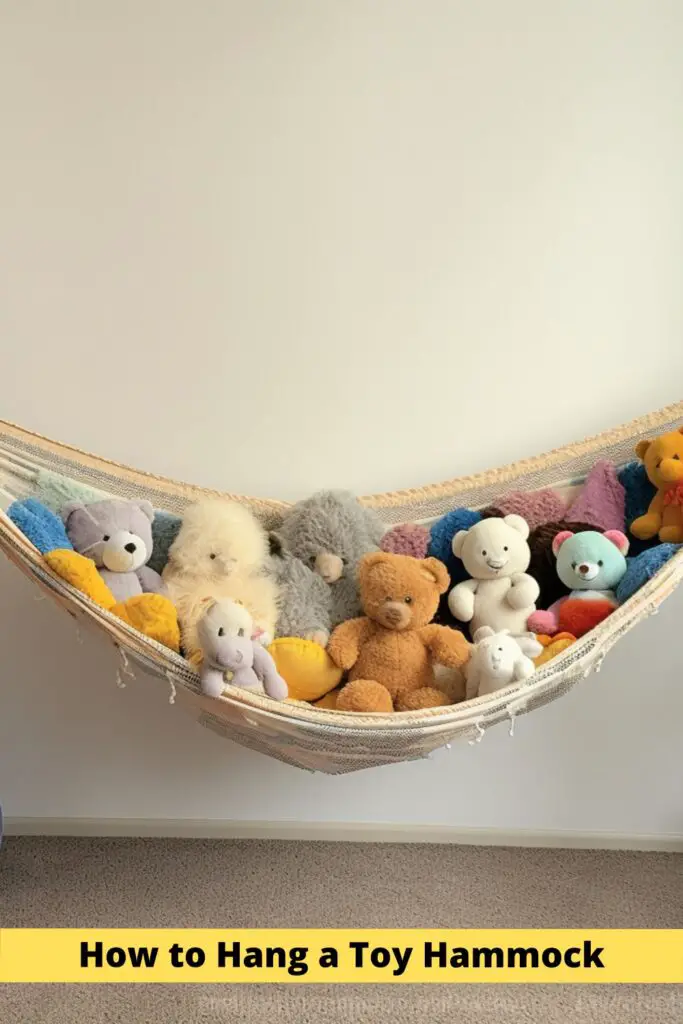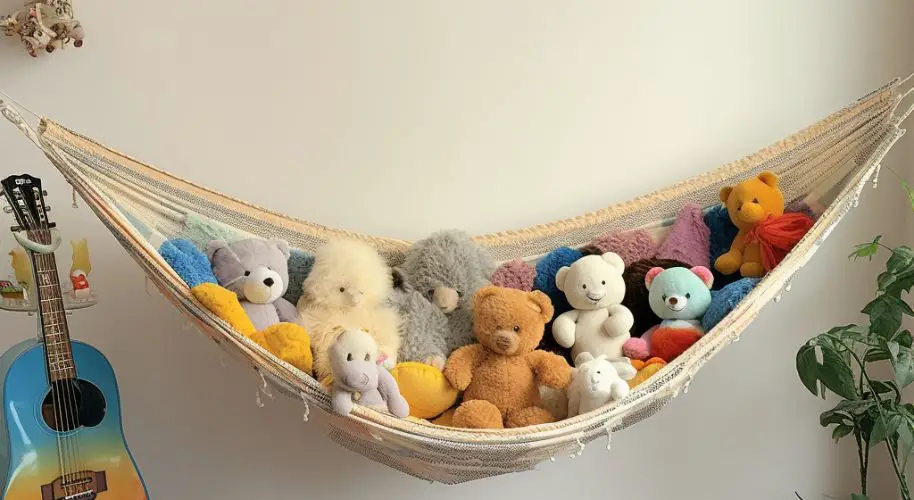Last Updated on June 5, 2025
Toy hammocks are a fantastic solution to keep your child’s room tidy and organized while showcasing their favorite plush friends. However, the process of hanging one may seem daunting at first. This guide is designed to help you navigate through the process effortlessly. You’ll learn to select the perfect spot, what tools you need, and the most effective method for securing the hammock.
Whether you’re a DIY novice or a seasoned pro, this step-by-step tutorial will make hanging a toy hammock simple and stress-free. Transform your child’s space into an organized, fun-filled haven!

How to Hang a Toy Hammock?
Introducing your guide to hanging a toy hammock, a practical solution to keep your child’s toys organized and off the floor. Let’s dive into the process and address some common questions.
Choosing the Right Spot
Before you start, identify the best location for the toy hammock. It should be a corner space that’s easily accessible but doesn’t obstruct movement. Measure the available space to determine the appropriate size for your hammock.
Gathering the Necessary Tools
Once you’ve found the perfect spot, gather your tools. Most toy hammocks come with the necessary hardware, including hooks and anchors. If not, you’ll need to purchase them separately. Additionally, you’ll need a drill, a pencil, a tape measure, and a level.
Marking the Spots
Using your tape measure, determine the height you want to hang the hammock and mark it on the wall with your pencil. Ensure that it is at a height your child can easily reach. Repeat this process on the adjacent wall. To ensure the marks are level, use your level tool.
Drilling the Holes
After marking the spots, it’s time to drill the holes. Use a drill bit that matches the size of your wall anchors. Drill into the marked spots at a perpendicular angle to the wall. Make sure to drill deep enough for your wall anchors, but be careful not to hit any electrical wires or pipes.
Inserting the Wall Anchors
Next, insert the wall anchors into the drilled holes. You should gently hammer them into place if they’re a tight fit. These anchors will provide the necessary support for the weight of the toys.
Attaching the Hooks
With the anchors in place, you can screw the hooks into the wall anchors. Ensure they are tightly fixed to the wall.
Hanging the Toy Hammock
Now that the hooks are securely fastened attach the toy hammock. Most hammocks have loops or rings at their ends for easy attachment. Hook one end onto one hook, stretch the hammock to the other and attach it. Ensure the hammock is taut but not overly stretched.
Adding the Toys
Finally, populate the hammock with toys. Distribute them evenly to prevent the hammock from sagging on one side. Keep heavier toys in the middle to balance the weight.
You Might also Like These Resources!
Why It’s Important to Hang a Toy Hammock Properly

The importance of properly hanging a toy hammock cannot be overstated. The first and foremost reason is safety. A poorly hung hammock can pose a risk for both children and adults. Someone might bump into it and get hurt if it’s too low. If it’s too high, children may attempt to climb furniture to reach their toys and potentially injure themselves.
Additionally, a hammock that isn’t properly secured can come loose under the weight of the toys, leading to accidents or damage to the toys themselves. Therefore, ensuring the hammock is securely fastened to the wall is crucial. This requires using the appropriate hardware, such as sturdy hooks and wall anchors, and ensuring they are firmly anchored into the wall.
Another reason to properly hang a toy hammock is to ensure its longevity. When hung correctly, a hammock can last for years, providing a convenient and attractive storage solution for your child’s toys. On the other hand, if the hammock is stretched too tightly between the hooks or overloaded with toys, it can wear out quickly.
Hanging Toys in A Hammock: Safety Considerations
Safety should always be the top priority when hanging toys in a hammock. Start by ensuring the hammock itself is securely fastened to the wall. Check regularly that the hooks are still tight and that the hammock material isn’t showing signs of wear or tear.
The height at which the hammock is hung is another important safety consideration. It should be within easy reach of your child but not so low that it poses a tripping hazard. If your child needs to climb or stretch to reach their toys, it’s too high.
The type of toys you put in the hammock matters too. Avoid heavy or sharp toys that could cause injury if they fall out. Similarly, keep the hammock manageable; having two hammocks is better than one overly full one. Overloading can lead to the hammock sagging or falling loose from the wall.
Finally, teach your child how to use the hammock safely. They should understand it’s not a swing or something to pull on or hang from. With the right precautions, a toy hammock is a safe and effective way to store toys.
Maintenance and Care
Maintaining and caring for a toy hammock will extend its life and ensure it stays safe and functional. Regularly check the hammock for any signs of wear and tear. This includes checking the material for holes or fraying and the hooks for looseness. If you spot any issues, address them immediately to prevent further damage or potential accidents.
Cleaning the hammock is also part of its maintenance. Most toy hammocks are made of easy-to-clean materials like nylon or mesh. You can usually remove the hammock from the hooks and wash it in warm soapy water. Rinse it thoroughly and let it dry completely before rehanging it.
Remember also to clean the toys that go in the hammock. Dirty toys can stain or damage the hammock material. Plus, regular cleaning keeps the toys hygienic for your child to play with.
In conclusion, while a toy hammock is a simple item, it requires proper installation, sensible use, and regular care to ensure it serves its purpose effectively and safely.
FAQs
What is the best height for a toy hammock?
The ideal height for a toy hammock largely depends on the age and height of your child. It should be hung so they can comfortably reach their toys without climbing or stretching. This encourages independence and makes tidying up easier for them.
However, it’s also important to ensure the hammock is high enough to become a tripping hazard or obstruct movement in the room. A good rule of thumb is to hang the hammock at your child’s chest level—high enough to avoid accidental bumps but low enough for easy access. Remember, the goal is to create a safe and convenient storage solution for your child’s toys.
How often should I check the hammock for wear and tear?
Regularly inspecting your toy hammock for any signs of wear and tear is essential for maintaining its safety and durability. How often you should check it depends on how heavily it’s used. If your child uses it daily and it holds many toys, you should check it weekly.
Look for things like fraying material, loose stitches, or weakening of the fabric. Also, check the hooks and wall anchors to ensure they are still securely in place. Any issues should be addressed immediately to prevent accidents. If the hammock shows signs of wear, it’s probably time to replace it.
Is any fabric suitable for creating a hammock to hang stuffed animals?
While you technically can use any fabric, not all fabrics are equally suitable for a toy hammock. The best material is durable, stretchy, and machine washable. Mesh or netting is often used because it’s lightweight, strong, and lets you easily see the toys. Always consider the weight of the toys and the fabric’s durability before making your choice.
Is there a weight limit for toy hammocks?
Yes, different toy hammocks have different weight capacities, which the manufacturer should specify. It’s crucial to be aware of this limit to prevent overloading the hammock. Overloading can lead to the hammock sagging and even falling, which could result in damage to the toys and potential injury.
If the manufacturer’s information doesn’t provide a specific weight limit, a general guideline is to fill the hammock with lightweight toys until it’s about two-thirds full. This allows some room for the hammock to stretch without being overly strained. If you’re frequently exceeding the hammock’s capacity, it may be worthwhile to invest in an additional hammock.
Final Thoughts
Hanging a toy hammock is a simple and effective way to keep your space organized while adding a touch of fun. You can ensure a safe and secure installation by following the steps outlined. Remember to choose the right location, measure accurately, and use the proper tools. Regular maintenance will keep the hammock and toys in good condition.
With toys off the floor and neatly arranged, you’ll create a tidy environment that encourages creativity and play. Enjoy the benefits of a clutter-free space and a happy, organized home.
You Might Also Like These Latest Content!

